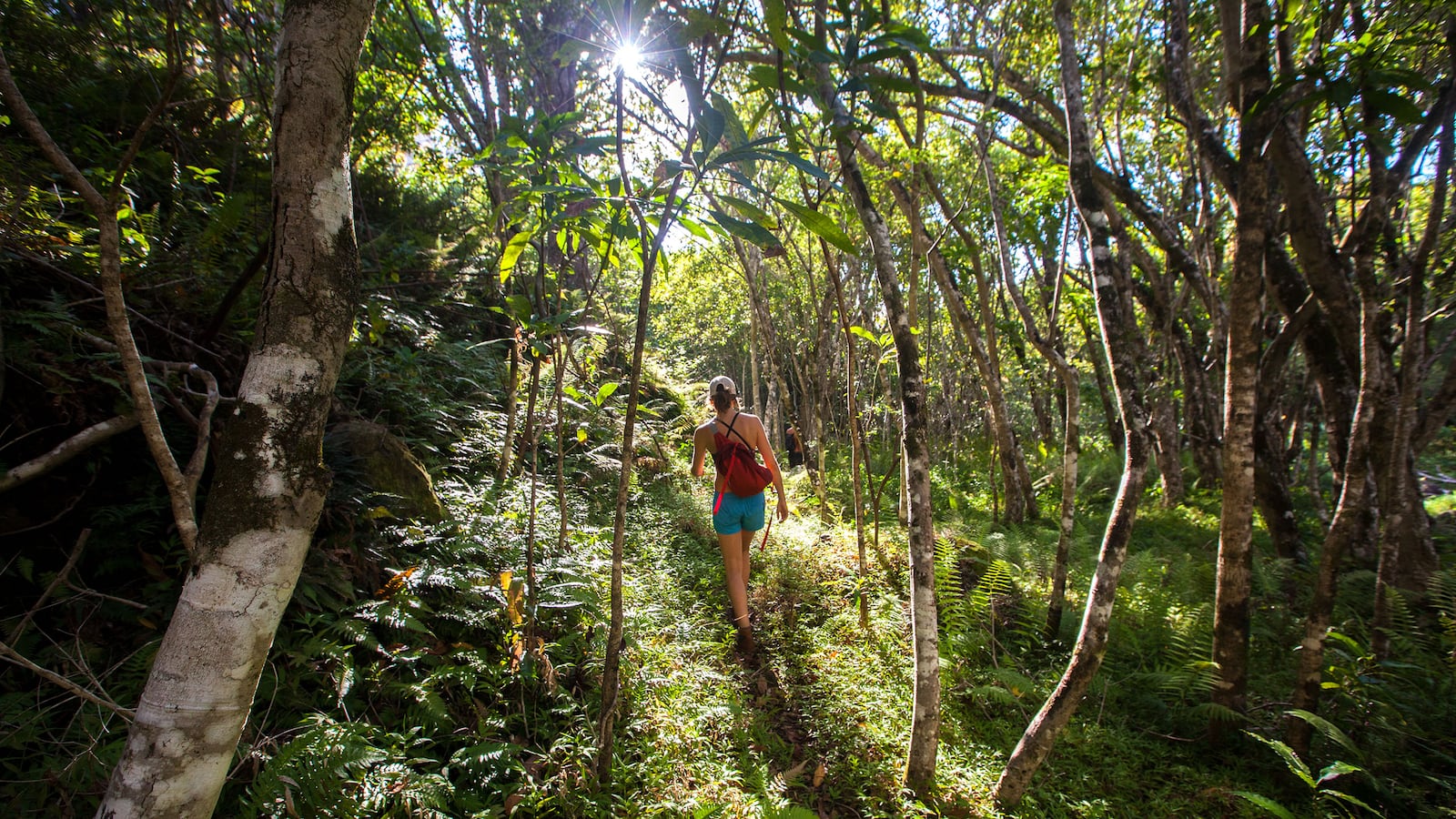I arrived at the start of Hawai’i’s Kalalau Trail to a packed parking lot at Ke’e Beach on the north end of the island. Without a permit, you can only hike the first 2 miles, plus an extra spur up to Hanakāpīʻai Falls. It overflowed with hikers, joggers, and others who clearly didn’t do much homework about a trek Outside Magazine declared one of the world’s most dangerous, traversing its muddy cliffs in flip-flops and Crocs. And by “muddy,” I mean, thick, soupy, slippery, peanut butter mud. The kind that forms a casing around your boots, mummifying traction lines at the sole, impossible to kick off. And with every 10 new hikers treading the same ground, the soup gets a little deeper. Those first 2 miles are a crowded, humid shit show.
This is the kind of scene to which I’d normally never imagine returning. From the Vatican to Venice, Acropolis to Angkor Wat, I decided years ago that if it’s in the top five Tripadvisor offerings, I’m content to stay home and look at the pictures, thanks. Traveling thousands of miles only to wind up shoulder-to-shoulder with babbling American slow-walkers blocking the view as they jam cellphones in front of us all for the perfect Instagram just isn’t worth the irritation. I’ve crossed the Seven Wonders of the World off of my bucket list.
But something about that first 2 miles of the Kalalau Trail warranted an exception to that cantankerous rule. Hawai’i is a mystical place, but I can’t say it was anything otherworldly that called me back here years after I slopped my way to and from the permit-free stretch.
It was the scenery: a stunning series of tropical portraits backdropped by sheer lava cliffs plummeting into a turquoise, empty ocean. You reach one viewpoint, ducking out of the stream of hikers for a photograph, and think “this is the most beautiful thing I’ve ever seen.” And then you round another bend, a completely different vista looms into view, and suddenly the last vista has a competitor. This feeling happens over and over again, and it supersedes any other frustrating moment. Neither mud nor a human traffic jam nor the Alabama-level humidity nor the steep slopes can take it away. Around every corner, even on that first 2 miles, lies a new dose of unadulterated joy. As soon as I finished the hike, I knew I had to see what the rest of the Na Pali Coast past the 2-mile mark looked like. I had to return to the Kalalau Trail.
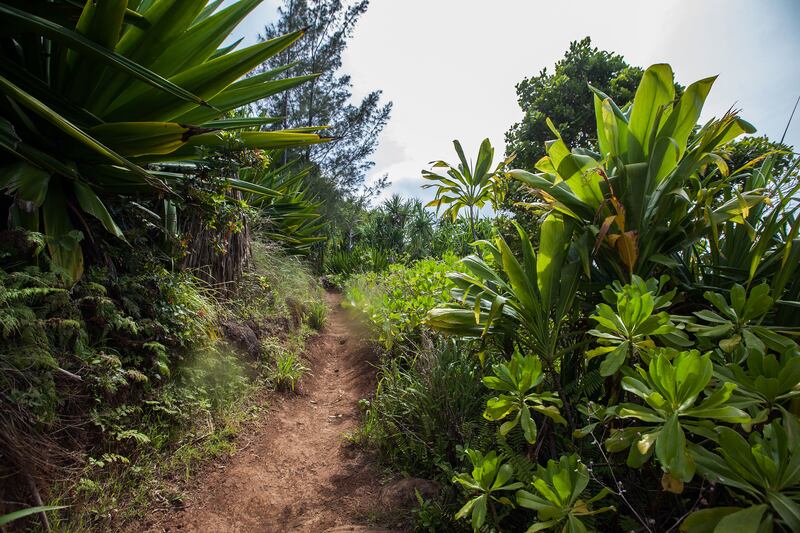
Three years later, my partner and I found a week in our schedules to get back to Kaua’i, and with enough advance notice that we could register on the state of Hawaii’s arcane website for a camping permit, which hikers risk arrest if they fail to acquire, I learned. That seemed harsh, but a little research revealed the reason: The Na Pali Coast has become overrun in recent years, not just with to-and-fro hikers but with a legion of wayward hippies who have turned it into a kind of commune. They have flouted laws designed to keep this pristine place from being loved to death, building beds, furniture, a clay pizza oven, and gardens in the 6,000-acre Kalalau Valley, diverting water from natural streams with neither consultation nor approval from the government for their own use. Though they are routinely snatched up and jailed by rangers who make surprise visits to the coast via helicopter, they always return: defiant, entitled.
So yeah, you need a permit, which not only funds the manpower necessary to keep people from overstaying their welcome but also gives the state a way to limit the number of visitors who venture past the 2-mile mark. I found three nights together, and snatched them up, for $132.
There’s some ambiguity about whether permitted nights cover only the camping that takes place at the end of the trail or at the halfway point, Hanakoa, about 6 miles in, where a rustic collection of campsites and a couple of rain shelters offer a respite for backpackers who don’t want to attempt the entire 11 miles in a day. So we planned for five nights out, three at the end and one each at the halfway point on the way there and back. And we packed for glamping: a tent, two hammocks, a couple books, a bluetooth speaker, and a bag of coconut milk. The pack would be stupidly heavy, but we’d have three days of music, good food, and reading material in paradise. What could possibly go wrong?
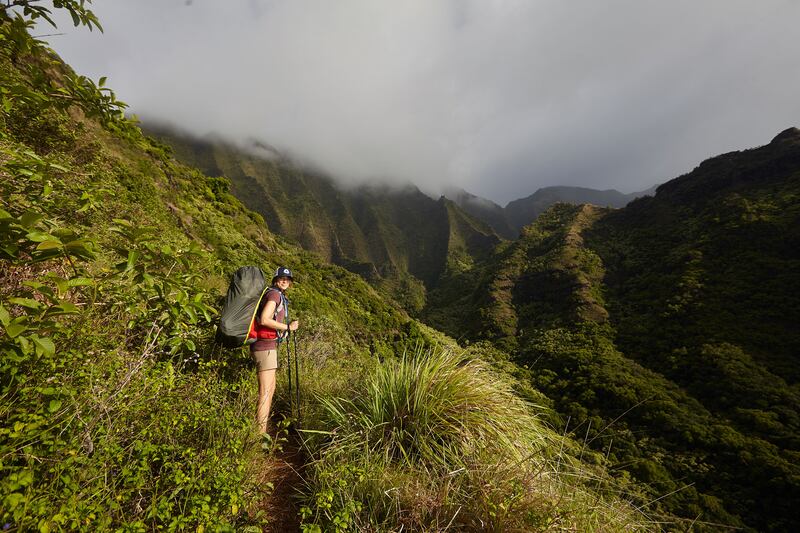
The pack being stupidly heavy, is what. Even those first couple of tourist-ridden miles were brutal with a 50-pound pack aboard, no matter the pride we felt at being able to answer “yes!” to passing hikers who enviously asked if we were headed past Hanakāpīʻai and into the lesser trod permit-zone, the whole way to Kalalau Beach. We were indeed. We just had no idea how difficult and dangerous the journey would be.
Each year, hundreds of hikers charge all the way from the trailhead to the beach. The reason this trail is named one of the U.S.’ top 10 dangerous hikes, and one of the world’s top 20 dangerous hikes is because it’s deceptively treacherous.
You’re in Hawaii, in America. It’s gorgeous. It’s a well-traveled, well-known trail. But the Kalalau Trail has claimed dozens of lives.
There are flash floods along the creeks. At least 100 people have died swimming in the powerful surf. In 2012, a drug-addled lunatic who’d spent a few too many illicit weeks in the valley threw a Japanese hiker off a cliff two days after Christmas, prompting international headlines, a four-month manhunt, and a clean sweep of the vagabonds. Two years later, rescuers had to pluck 120 people by helicopter from the trail after a flash flood made a stream crossing impossible.
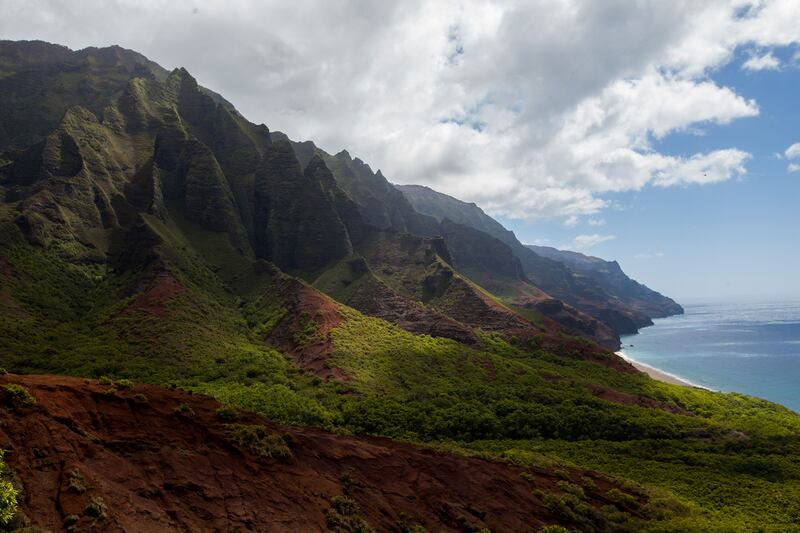
There is no cellphone coverage in the valley, but there are signs at regular intervals along the trail warning of its danger. They’re foreboding, but they’re also so dramatic it’s hard to take them seriously. These are for weekend warriors, I wrongly assumed. (I hadn’t yet read the Backpacker or Outside designations.)
The first day’s hike was a brutal slog. The Kalalau’s beauty belies its rugged reality: The trail runs either along the edge of a cliff or winds back into a series of valleys. When those inland passages are wide, there’s enough room to flatten them out for hikers. But sometimes they’re a pinch between two bluffs, and sometimes the only way to reach the turning point is a jagged set of switchbacks down, and another one back up. During the first mile of permit-only hiking, the trail rises 800 feet. The downhill, especially with a menacingly large pack, results in a steady pounding of the hips and knees. But hey, the pack would get lighter with each meal, and each pull from the water bladder. Nowhere to go but up, really.
We finished the first 2 miles in a couple of hours, then stopped at Hanakoa close to dark, just as a thick rain began to fall. There were loud teenagers occupying every site in sight, so we clambered up a creek and found an unestablished spot close enough to the water to drown out the noise but far enough away (we hoped) to be clear of a flash flood. Amelia, my partner, slipped crossing that creek, twisting her ankle. We ate the fastest food we could prepare and plunged into sleep.
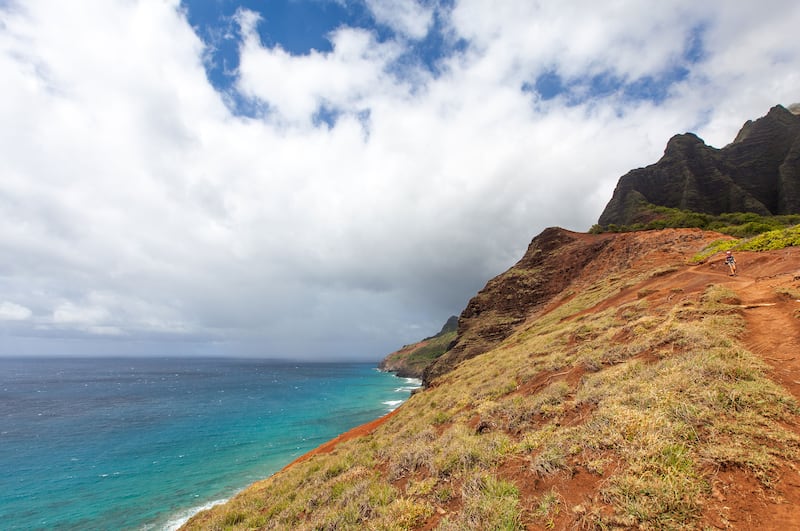
The next morning, we awoke and readied our packs, lighter by at least a pound or two thanks to last night’s dinner and to stashing our heaviest meal-in-a-bag behind a rock for the return journey. A few feet down the trail we discovered what we’d been too exhausted to scout the night before: a second set of campsites on the other side of the creek, none of them occupied. We pushed on.
We had five miles to go. The second day of backpacking is always better because your lungs have expanded to meet new demands placed on them, and always worse because your body is still reeling from being abused the day before. I have backpacked up and down (reasonably sized) mountains, through deserts hugging the U.S.-Mexico border, portaging a canoe through a series of Alaskan lakes hounded by hummingbird-sized mosquitoes, and through the Olympic mountains with a tiny broken bone in my foot. This day of hiking was as hard as anything I’ve ever faced. It was so trying we scarcely noticed (and continued to underestimate) the increasing urgent signs approaching a cliffside we would come to know as “Crawler’s Ledge.”
It’s called that, we were about to discover, because one must crawl along a path carved into the rock at what certainly feels like a 45 degree angle. On the left side of that path is rock, with nary a chain nor rope to hold. On the right side is more rock, leading some 20 stories down to the ocean, where massive waves bash anything in their paths against the cliff.
Somehow, on the way out, the prospect of tumbling down that cliff frightened neither of us, and I know this because despite our still impossibly heavy packs, I swung my camera around to snap a few photos of Amelia crawling her way around the ledge. I got no such photos on the way back through.
We made it across without thinking too much about it, which is of course the ideal way to surmount fear: by not experiencing it in the first place. The only real heart-stopping moment came about halfway across the ledge, when a gust of wind ripped the rain cover right off of my pack and into a canyon, so quickly I couldn’t even think to reach for it. When we’d both arrived at the sign warning of the same danger in the opposite direction, we realized that was probably the most precarious few steps we’d ever taken. As American writer Laurell K. Hamilton once put it: “I’m not afraid of heights, but the idea of falling from them, well, that I’m afraid of.”
The rest of the trek remained excruciating, but wood-carved mile markers urged us onward. As did magical little discoveries: wild lime and mango trees with ready-to-eat fruit dangling from their branches. We gathered up enough of the bounty to make our packs heavier but our freeze-dried meals more interesting, and pushed ahead.
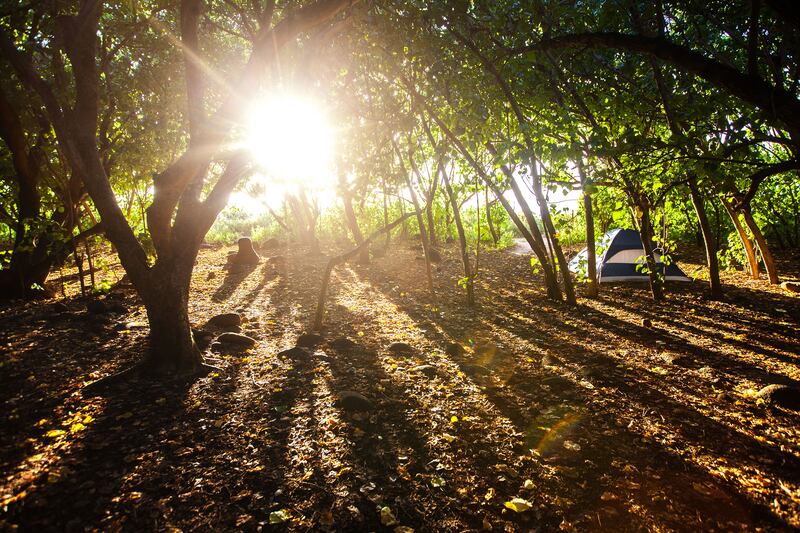
Finally, a couple of miles from Kalalau Beach came the most welcoming sign of all: the gateway to the Kalalau Valley, proof that we were only a relatively flat jaunt from home for three days. We bounded through the woods and out onto a wide bluff with a view of a crescent sand beach nearing ever closer. A half hour later, we’d finally arrived.
Thanks to the most recent roundups of would-be permanent residents of the Kalalau, we found after stumbling past a dozen friendly neighbors a campsite that looked right out onto the ocean, the only evidence of its past inhabitants a frying pan dangling from a branch. We gladly used it. The site was conveniently only a five-minute walk to the freshwater source: a tumbling waterfall just off the beach. As we’d come to expect by then, even collecting water is a dangerous activity in this particular paradise: goats clambering across the cliffs above are known to kick substantial rocks onto unsuspecting tourists below. It’s a real threat, and it’s why no one collects water alone on Kalalau Beach.
Our nearby neighbors were a cheerful couple of teachers from Oahu, and they were eager to share a flask of bourbon, and to show us the Eden that the valley’s squatters had built a couple miles from our camp.
It’s a remarkable feat, albeit an illicit one, this garden. There are a dozen irrigated ponds, and trees of banana, jackfruit, soursop, and chestnut. To get there, we had only to look for a conspicuously placed stick in an otherwise nondescript deer trail leading from the main path. We munched on fresh mangoes, gathered up handfuls of mint, squash blossoms, a papaya, and an avocado and headed back to camp.
I’ve mentioned “paradise” a couple of times now, and without question, the Kalalau Valley qualifies as paradise. But it’s also hot, humid, filled with mosquitos and wily felines with a knack for stealing food, a beach that’s too windy to lie out on, surf with an undertow far too strong to safely swim in and rock-kicking goats. Our three days on the beach were in all the ways you’d expect idyllic, but also trying enough that we were ready to leave by the third day, despite our dread for the return to Crawler’s Ledge.
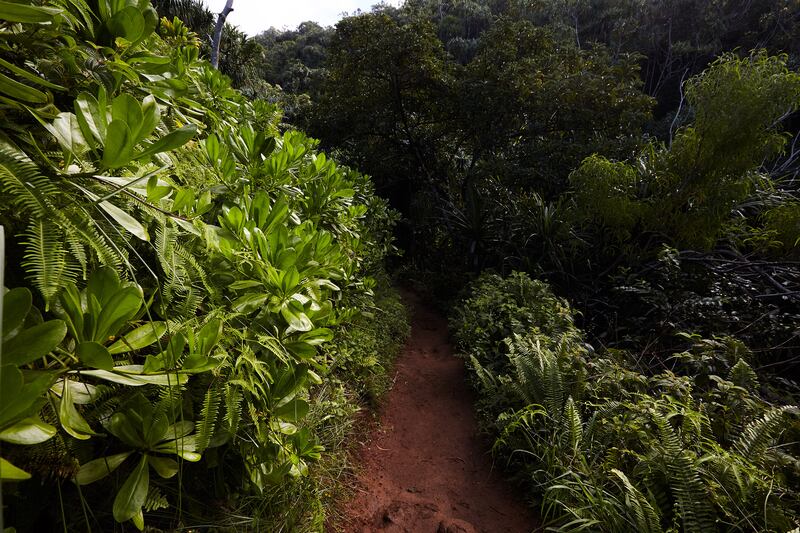
Our new friends took the “easy” (and illegal) way out. They arranged for a dude on a Jet Ski to roll out on the morning of their departure and pick them up. (Picking up or dropping people off on this beach is banned except in emergency cases.) We considered this option too, figuring we’d still be able to say “I hiked the Kalalau Trail” with pride, but as we watched the dicey dance of throwing backpacks wrapped in trash bags out into the breaking surf to be collected on a Jet Ski and then the feat involved in swimming out between the waves to climb aboard, we decided to hike out.
Knowing what lay in store upped our anxiety levels tenfold. Even with packs nearly empty and without the wind-whipped rain that we’d encountered on the way out, the building anticipation crawled into my head each mile closer we got to the ledge. I feigned a carefree demeanor as we approached, hoping to distract Amelia, but at the warning sign, I fell silent, concentrating on keeping my balance shifted slightly away from the ocean. If I fell, I wanted to fall to the right. We paused at the dreaded warning sign marking the stretch that had disrupted our sleep the night before: “Hazardous Cliffs Ahead.” A few terrifying moments later, we were on the other side.
Overcoming that obstacle left us with new energy, and we charged back to the halfway mark well ahead of schedule. At the shelter we’d overlooked the first night, we heard a voice call out from above: “Hey, do you like wild boar?” It was one of a group of Kalalau squatters, on their way back from a supply run. They’d killed not one but two wild boar (I didn’t ask how) and had stopped to make a giant pot of stew, to lighten the load. How they carried the pigs or the pot for 11 miles was hard to fathom. We took a respite from the now falling rain, sharing potato chips with the group as they piled hot wild boar stew onto plates and handed them over. We ate, grateful, as a young man strummed a guitar from the hammock he haphazardly strung inside the shelter. The stew was delicious.
On the last few miles, we beamed with pride as we knew we were about to blast through this entire hike in a single day, and we dreamed of what warm food we’d plow into once back in civilization. But before we got there, we caught up with a couple also on their way back from camp. The woman mentioned, almost in passing, that she’d just fallen off a cliff.

